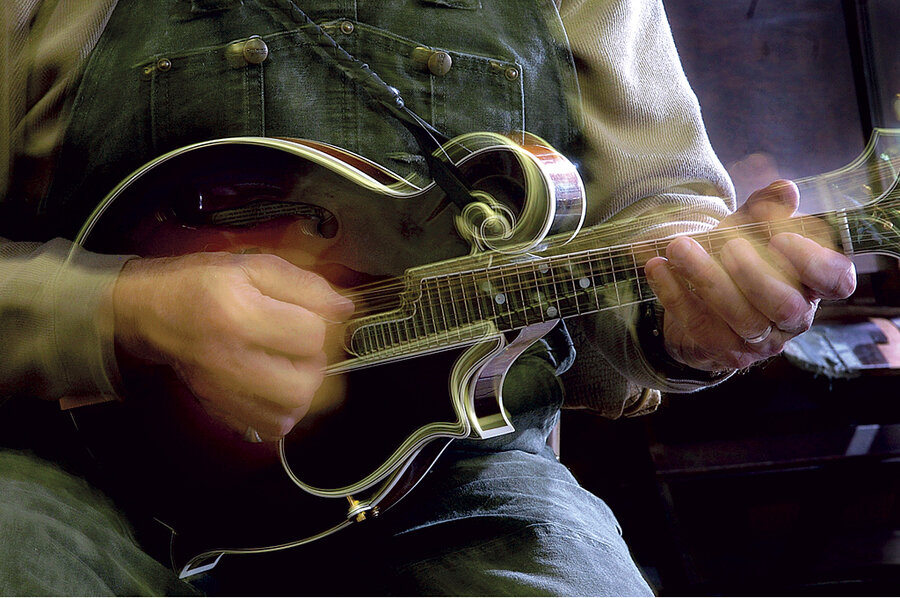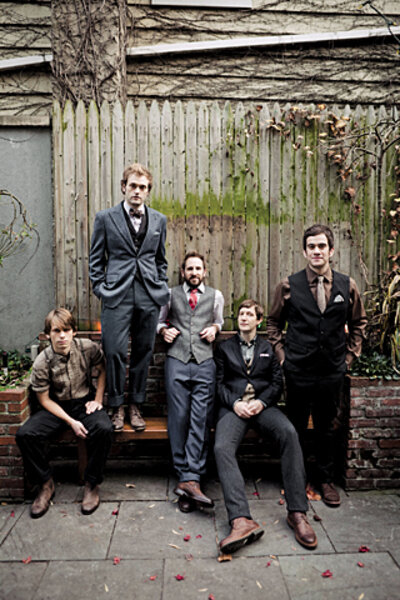A plucky revival
Loading...
| Somerville, Mass.
It's opening night for the tour, and the Punch Brothers have hit a groove in the Somerville Theater. The sound of their latest album, "Who's Feeling Young Now?," is modern, insistent, and rhythmic, and the lyrics tell of the 20-something's life of attraction, pain, and love affairs put on hold. Up front, band leader Chris Thile swivels like Elvis, ripping out solo after solo on his vintage Gibson mandolin.
For self-identified traditionalists, it's a visual and aural shock to the system, a bit like holding a Metallica concert at the Grand Ole Opry. But the fans love it. Some have been following Mr. Thile since he was a chubby little grade school mandolin god, wowing the crowds at bluegrass festivals with the child-band Nickel Creek. Many more have joined the fan base, as Thile's tastes changed, and stuck with him as bands came and went.
It's been more than a century since the mandolin has been this prominent in popular music. In the late 1800s, there were mandolin orchestras in every major city of the United States. The guitar gradually overtook the mandolin in popularity, driven by the invention of amplified guitars in the 1920s. Until Bill Monroe appeared on the scene in the 1930s, the mandolin had been receding into the background. But Monroe's supercharged high-speed style, mixing white old-timey music with African-American blues, brought the mandolin back to center stage.
Today's musical changes are no less dramatic. The transformation has been led by Thile, Sarah Jarosz, Sierra Hull, and a host of 20-something pickers. Once an ethnic accent – think of R.E.M.'s song "Losing My Religion" or Rod Stewart's "Maggie May" – the mandolin has become an instrument that can hold its own in many different styles, from jazz to samba, from folk to rock, from klezmer to punk.
"I have to think of what it was like when folks at the Grand Ole Opry heard Bill Monroe for the first time; it must have seemed like that when people hear" what the younger generation is playing, says Stuart Duncan, fiddle player for the Nashville Bluegrass Band, who recorded the classical/bluegrass album "Goat Rodeo Sessions" together with Thile, Yo-Yo Ma, and Edgar Meyer.
"But I think it's fair to mention that what people are calling traditional bluegrass music dates back to only 1948," Mr. Duncan says.
Like Monroe, the acknowledged founder of bluegrass in the mid-1940s, today's younger generation is applying other musical forms to traditional music, giving it a language that younger audiences can appreciate. It's all about referencing the tunes that people are familiar with. Older audiences may hoot when a fiddler adds a line from "Cluck Old Hen," but they howl when a younger musician plays a riff from Britney Spears's "Toxic" or the Beatles' "Day Tripper." And yet, it's these modern touches that are bringing a younger audience into the world of acoustic music.
George Gruhn, longtime owner of one of Nashville's top vintage guitar shops, says he has seen a huge growth in interest in acoustic music, and in mandolins in particular. Bluegrass festivals used to be numbered in the dozens back in the 1970s. Now there are more than 500.
The appeal, he says, is that bluegrass is accessible, and it invites participation. And with people living longer, healthier lives, baby boomers and their children are finding they have the time to readopt old habits and return to playing the music they enjoyed in their dating years.
"When people retire or go through their midlife crises, they start playing the music they used to play when they were of dating age," says Mr. Gruhn. With the baby boomers retiring, acoustic music is a booming business. "You can see it in folk music, and the mandolin today is vastly more popular than it was before. When you go to a bluegrass festival, you see thousands of people coming with their own instruments. There's more music offstage than there is onstage."
In truth, this is a revolution that has many fathers. David Grisman got his start in bluegrass in the 1970s but has branched out into jazz, Brazilian samba, klezmer, and Grateful Dead-style rock music.
"We played everything from traditional American fiddle tunes to jazz ballads, as well as a lot of my original music," says Mr. Grisman in an e-mail interview. "As Duke Ellington once said, 'There are only two kinds of music – good and bad!' I've always loved the 'good' stuff."
Some bands maintained the older "traditional" bluegrass sound, while innovators like banjo player Béla Fleck and mandolinist Sam Bush explored rock, jazz, and reggae with their band "New Grass Revival."
Thile sees himself as part of the latter school, cherry-picking sounds and styles from other musical genres that simply interest him.
"I think there's a wonderful thing happening in popular music; in the age of the Internet, where you have everything at your fingertips, it's silly not to allow the use of all the material that's available," says Thile, talking with the Monitor by cellphone while riding the Amtrak train back to his home in New York after a recent Boston concert.
It's been a busy year for Thile. He has just finished a very brief touring schedule with the classical/bluegrass quartet with Yo-Yo Ma, and a separate tour with bluegrass guitarist Michael Daves. Now he's touring with the Punch Brothers, playing music that sounds part Tin Pan Alley, part folk, and part Radiohead.
John McGann is Berklee College of Music's first mandolin instructor. Since 2004, when he had one student, he has taught 45 mandolin players, many of whom had chosen mandolin because of young new stylists like Thile. "It's like they are sitting at the feet of Chris Thile" when they first arrive, Mr. McGann says with a laugh. But by the time the students leave, they have a broader perspective.
"I think most people, when they hear quality music, they find it appealing," says McGann. "What I love about the Punch Brothers is that they remind me of The Police in the 1980s. They were quite popular and quite accessible, and people who did not dig too deep could still enjoy it. But there was also something deeper going on that appeals to people who are more musical."
At the opposite pole from Thile's "new"-grass style is Mike Compton, mandolinist for Nashville Bluegrass Band. Listen to his version of Monroe's "Evening Prayer Blues" and you'll think you're hearing the last lava bubbles of the creation story. But like his band mate Stuart Duncan, Mr. Compton says that bluegrass is a living, breathing thing that needs younger ideas and musical styles to survive.
"There will always be young people coming in and changing the way music is played," says Compton, speaking by phone from his home in Nashville. "Certainly Bill Monroe did that, and Chris Thile and his new generation of players are doing that now. He's sort of put the technical side of music into overdrive."
For his part, Thile is unapologetic about exploring new musical territory.
"I would contend that with both folk and other traditional disciplines, they tend to create music with an eye to the past, and what we are trying to do with Punch Brothers is to create music with an eye to the present," says Thile.
Thile describes live musical performance as almost a spiritual duty in an age where people cut themselves off from the world with iPods and miss the music of human contact.
"This music lends itself to a sense of community," says Thile. "We're living in an age of intense isolation, so if we are aware of the danger of that, we can use music to create a new sense of community with mankind."






